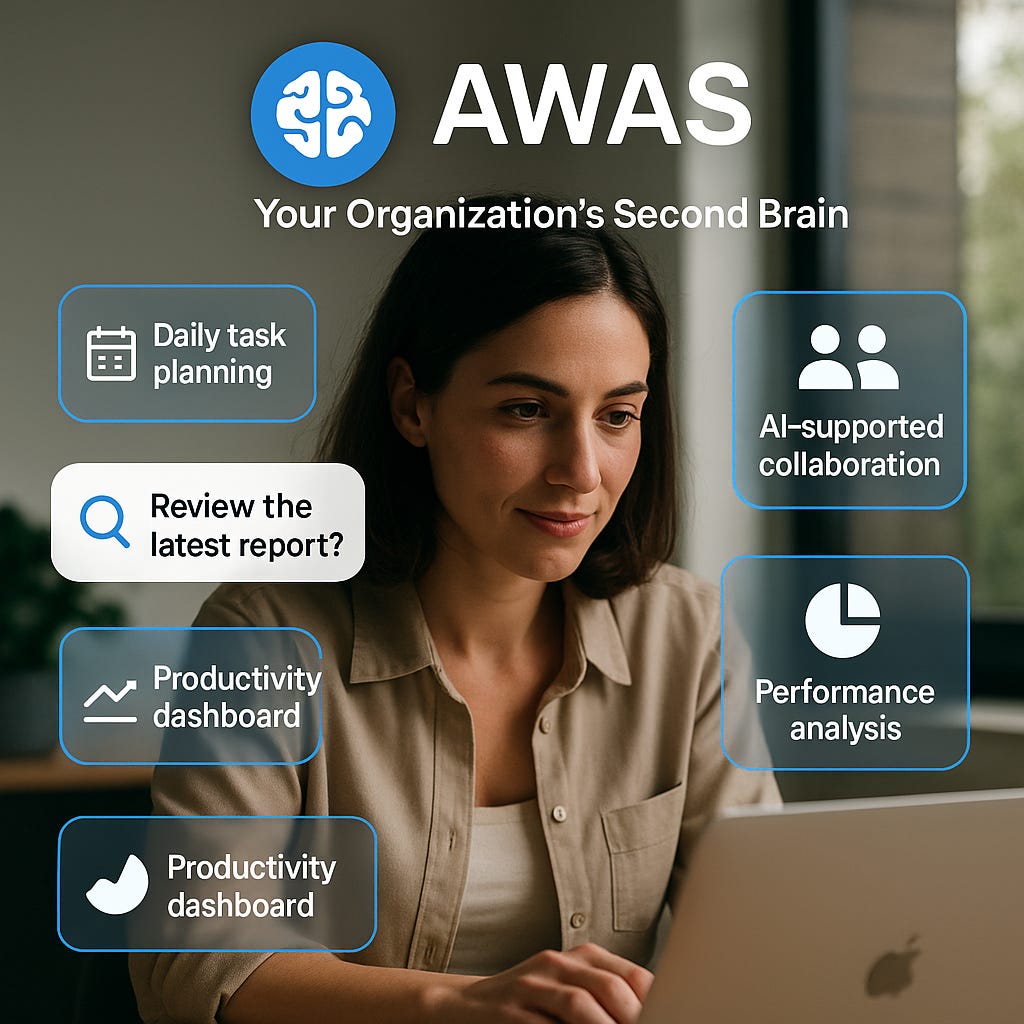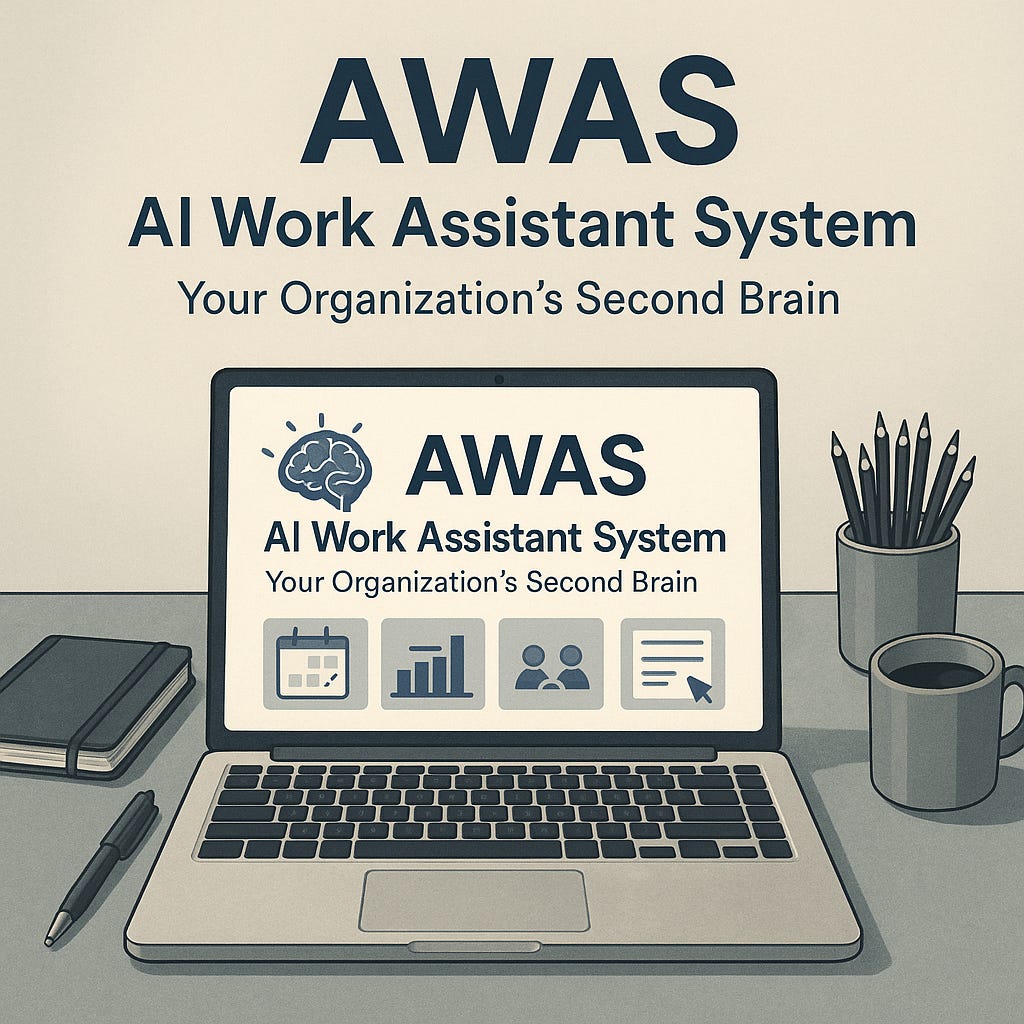📊 AI Work Assistant System (AWAS)
📊 AI Work Assistant System (AWAS)
"Your Organization’s Second Brain"
By Ronen Kolton Yehuda (Messiah King RKY)
🧠 Overview
The AI Work Assistant System (AWAS) is a unified AI-powered productivity platform designed to supervise, assist, and optimize work at all levels—across teams, departments, and individuals. It functions as a distributed, smart companion that:
-
Understands organizational workflows
-
Supports each individual according to their tasks, preferences, and pace
-
Provides intelligent supervision and feedback
-
Enhances planning, communication, and output
This AI doesn't just automate—it collaborates, serving as a digital assistant, productivity mentor, and operational analyst in one.
🔍 Core Capabilities
1. 🧑💼 Personal AI Assistants (Per-Employee Layer)
-
Daily task planning based on goals, calendar, and team dependencies
-
Priority reordering using smart algorithms
-
Real-time suggestions to reduce distractions and optimize time
-
Reminder & follow-up management
-
Smart summary of unread emails, chats, and meetings
-
Personalized productivity reports
2. 🏢 Organizational AI Dashboard (Managerial/Team Layer)
-
Bird’s-eye view of tasks, progress, and delays
-
Bottleneck and inefficiency detection
-
Smart delegation suggestions
-
Automated meeting scheduling with goal-oriented agendas
-
Resource allocation optimization
-
Confidential escalation of silent issues (burnout, overload, low collaboration)
3. 📊 Performance Supervision & Assistance
-
Productivity heatmaps (per individual, team, department)
-
AI-guided mentorship (e.g., writing help, design prompts, code assistance)
-
Emotional tone detection & suggestion (to improve communication tone)
-
Automatic documentation summarization & updating
-
“Silent helper mode” that nudges users only when needed
4. 🛠️ Task, Knowledge & Tool Integration
-
Native integration with project management tools (e.g., Jira, Asana, Monday.com)
-
Integration with communication channels (e.g., Slack, Teams, Email)
-
Real-time syncing with shared documents and folders (Google Drive, OneDrive)
-
Internal wiki management with auto-updates from work activity
🚨 Security & Ethics
-
🔐 Full role-based access control and personal privacy settings
-
🧭 Ethical filters: AI never punishes, only assists
-
🧠 All suggestions are explainable—"why" the AI recommends something is always visible
-
⚖️ GDPR and ISO-compliant with full audit logs
🧩 Use Cases by Role
| Role | Benefits |
|---|---|
| Employee | Better task flow, less stress, smart nudges to stay productive |
| Manager | Clearer oversight, faster decision-making, smarter team coordination |
| HR/Admin | Early detection of burnout, talent utilization insights |
| C-suite | Macro-analytics, organizational health metrics, strategic optimization |
🌐 Future Add-ons
-
Wearable device syncing (for wellness and ergonomic feedback)
-
Voice interface for hands-free command
-
Multi-language support with automatic cultural tone adjustment
-
AI-driven training and onboarding modules for new hires
-
Plug-in for Villan SmartSole and SmartScreen (if integrated into Villan ecosystem)
🏁 Summary
AWAS is not just an AI assistant—it’s an intelligent productivity and supervision ecosystem that elevates how humans and organizations work. It replaces chaos with clarity, overload with order, and stagnation with smart momentum.
🧠 Technical Architecture and Design of the AI Work Assistant System (AWAS)
By Ronen Kolton Yehuda (Messiah King RKY), June 2025
Abstract
The AI Work Assistant System (AWAS) is a distributed, role-aware, and task-oriented artificial intelligence framework built to assist, supervise, and optimize productivity across an entire organization—from individuals to departments and executive leadership. This article outlines the system architecture, AI modules, data pipelines, and operational layers that enable AWAS to function as an intelligent digital work assistant, integrated into the modern enterprise environment.
1. System Overview
AWAS is composed of three interlinked layers:
-
Personal AI Assistant Layer (PAAL)AI agents tailored to individual users, focusing on personal workflows, task management, cognitive load, and contextual assistance.
-
Managerial Intelligence Layer (MIL)Departmental and team-level analytics, collaboration monitoring, bottleneck identification, and recommendation engines for delegation and timeline adjustments.
-
Organizational Intelligence Layer (OIL)Strategic-level insight generation, performance monitoring across teams, and AI-driven optimization suggestions for resource distribution and project success.
Each layer operates semi-autonomously but synchronizes through a shared data model and ontology.
2. Core AI Modules
2.1. Task Understanding & Decomposition Engine
-
Parses tasks from emails, chats, voice, or documents
-
Uses NLP and semantic role labeling to break down tasks into subtasks
-
Assigns temporal estimates based on learned user patterns
2.2. Personal Workflow Modeler
-
Builds dynamic models of individual productivity patterns (e.g., peak hours, fatigue thresholds)
-
Predicts task completion probabilities and recommends optimal time slots
2.3. Interpersonal Collaboration Model (ICM)
-
Tracks dependencies between users (e.g., blocker relationships, communication frequency)
-
Suggests improved workflows and identifies invisible friction zones
2.4. Smart Suggestion Engine (SSE)
-
Offers real-time micro-suggestions:
-
Task reprioritization
-
Tone correction in communications
-
Focus-enhancing nudges
-
-
Context-aware and interruption-minimizing
2.5. Performance Supervisor Agent (PSA)
-
Builds productivity heatmaps
-
Flags bottlenecks, delays, or anomalous behavior
-
Can trigger silent HR alerts in burnout detection scenarios (privacy-aware)
3. Data Pipeline Architecture
[Input Sources]
3.1 Input Streams
-
Structured: Jira, Trello, Notion, Outlook, Google Calendar
-
Unstructured: Email bodies, chat messages, natural language notes
-
Sensor Data (optional): Wearables, browser behavior (via extension), SmartScreen logs
3.2 Output Streams
-
Task suggestions
-
Work summaries
-
Personal heatmaps and AI reports
-
Departmental performance reports
-
Executive strategy dashboards
4. Integration Framework
AWAS is built on a modular plugin architecture supporting:
-
API-first deployment (GraphQL & REST)
-
Webhooks for real-time updates
-
Embeddable UI modules for task panels, insights, and dashboards
-
Native App Integrations for Office365, Google Workspace, Slack, Teams, Zoom, and Villan devices (SmartSole, SmartScreen)
Authentication & Access:
-
OAuth 2.0, SSO, RBAC
-
Encryption: TLS 1.3 + End-to-end AES-256 for data-in-use
-
Auditing: Full role-aware logs with anonymization options
5. Privacy, Ethics, and Security
5.1 Role-Aware Access
Each AI insight is scoped based on permission trees. Managers see trends, not individuals. Individuals get full transparency into their data and AI’s rationale.
5.2 Ethical Guardrails
-
No punitive triggers
-
No silent surveillance (users are notified if monitored metrics are active)
-
AI explanations are required for every suggestion made
5.3 Compliance & Standards
-
GDPR, HIPAA-ready
-
SOC 2 Type II alignment
-
Custom data-retention and purge protocols
6. Future Enhancements
| Feature | Description |
|---|---|
| Voice AI Interface | AI assistant that listens and responds like a productivity coach |
| AR/VR Integration | Task visuals and dashboards in spatial interfaces |
| Wearable Syncing | Collects and interprets biometric signals for fatigue detection |
| Adaptive Coaching Layer | Personalized improvement plans for time management and collaboration |
| AI Agent Cloning | Simulates user work patterns to test workload scenarios before assignment |
7. Implementation Notes
-
ML Training: Uses federated learning to preserve privacy
-
Storage: Multi-cloud compatible with AWS, Azure, or Villan Data Systems
-
Latency Targets:
-
<100ms for in-app suggestions
-
<2s for cross-department analysis reports
-
-
Open Standard Support: JSON-LD for knowledge graph, Web Components for UI modules
Conclusion
AWAS represents a new generation of task-performing AI systems embedded within the enterprise fabric. Rather than replacing workers, it augments and enhances them—balancing personal productivity, team coherence, and organizational efficiency. Designed for ethical, secure, and highly integrative deployment, AWAS is positioned as a foundational layer for the next era of intelligent work ecosystems.
🧠 AWAS – The AI Work Assistant System That Transforms Productivity
By Ronen Kolton Yehuda (Messiah King RKY), June 2025
In today’s fast-moving world, organizations need more than task lists and shared drives—they need intelligent systems that understand people, workflows, and the fine balance between effort and efficiency. Enter AWAS: the AI Work Assistant System designed to elevate how individuals and entire organizations function.
What Is AWAS?
AWAS (AI Work Assistant System) is a smart, organization-wide AI platform that supports both teams and individuals in doing their best work. It doesn’t just track tasks—it helps people plan better, work smarter, and make better decisions, every day.
From junior staff to executive leaders, AWAS acts as a personal assistant, project supervisor, and smart advisor, rolled into one system.
Why Organizations Need an AI Assistant System
Most workers juggle too many tools—emails, calendars, project boards, chat apps—without a clear view of what matters most. Managers struggle to understand where delays come from. Leadership often lacks real-time, actionable insights.
AWAS solves these challenges with a unified system that:
-
Understands tasks in natural language
-
Learns user work patterns and preferences
-
Provides real-time suggestions
-
Surfaces team and company-wide performance issues before they escalate
-
Assists—not replaces—humans in becoming more effective and less overwhelmed
Key Features at Every Level
🧑💼 For Individuals: Personal AI Assistants
-
Smart daily planning with calendar and task syncing
-
Personalized work reminders and nudges
-
Priority reshuffling when deadlines shift
-
Friendly summaries of emails, messages, and meetings
-
“Focus mode” recommendations to reduce distractions
👥 For Teams: AI-Supported Collaboration
-
Clear overviews of team progress
-
Smart delegation suggestions based on workload
-
Early alerts on stuck tasks or blockers
-
Automatic meeting agendas based on project needs
-
AI-generated performance summaries
🏢 For Organizations: Executive Intelligence
-
Productivity heatmaps across departments
-
Bottleneck and delay detection
-
Real-time trend monitoring
-
Suggestions for shifting resources or timelines
-
Confidential burnout and overload alerts for HR
How It Works
AWAS integrates with tools your team already uses—Slack, Teams, Google Workspace, Outlook, Trello, and more. It watches how work flows (without spying) and builds intelligent patterns around tasks, communication, and time usage.
Then, using advanced AI models, it:
-
Breaks tasks into manageable steps
-
Suggests better scheduling
-
Flags problems or risks early
-
Offers improvement tips to individuals and managers alike
Everything is fully customizable, and every user can control how much or how little the system is involved.

Privacy & Ethics First
Unlike surveillance systems, AWAS is designed with trust and transparency in mind.
-
It never penalizes—it only advises.
-
Every suggestion includes a “why.”
-
Employees control what the AI sees and does.
-
Managers see trends, not personal behavior—unless consent is given.
-
The system complies with GDPR, HIPAA, and leading security standards.
Real-World Benefits
AWAS creates a culture of supported excellence, where people feel guided but never pressured. It’s like having a thousand smart assistants quietly working to help everyone do their best.
The Future of Work, Now
The future of work isn’t just about remote teams or digital tools. It’s about smarter collaboration, personalized support, and AI systems that truly understand people and tasks.
With AWAS, organizations no longer guess where to improve—they know. Employees no longer drown in to-do lists—they rise above them.
Welcome to the intelligent workplace. Welcome to AWAS.














תגובות
הוסף רשומת תגובה